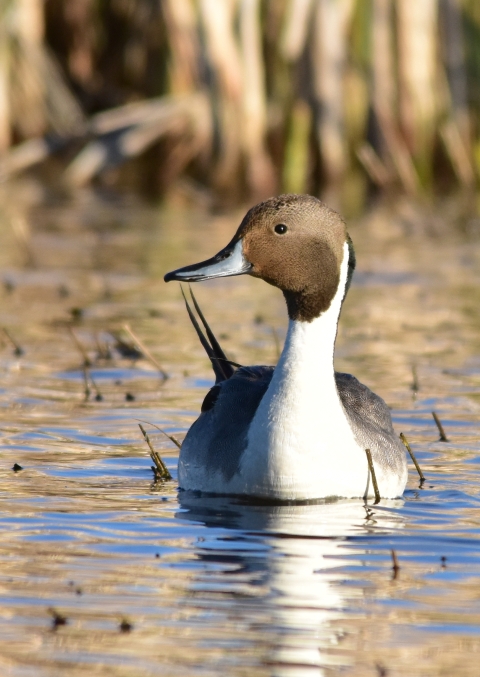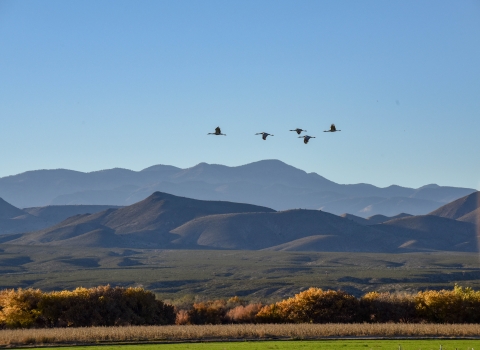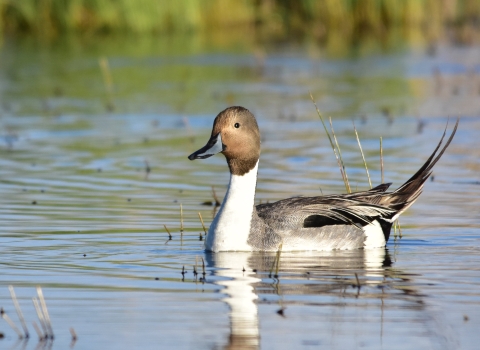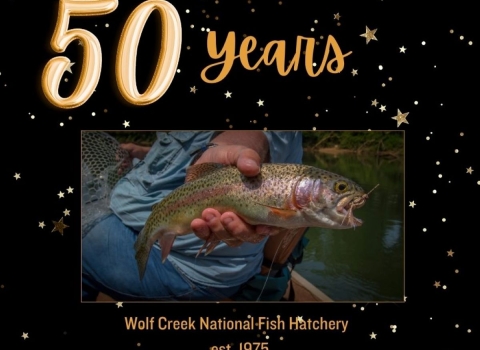Interim Northern Pintail Harvest Strategy
Migratory game bird hunting seasons offer opportunities for recreation and sustenance, while also aiding Federal, State, and Tribal governments in the management of game bird populations. To guide appropriate season lengths and bag limits for species of special concern (including Northern pintail, black ducks, scaup, and eastern mallards), we use species-specific Adaptive Harvest Management (AHM) strategies. Species of special concern are species that may be vulnerable to habitat impacts or show signs of population decline. Species-specific AHM strategies help inform hunting rules for these species in the face of uncertain regulatory impacts to reduce that uncertainty over time.
Northern pintails are a special concern species with specific harvest strategies recommended by the four Migratory Bird Program Administrative Flyway Councils. These Councils get advice from committees made up of biological experts from state, provincial, and territorial agencies in the Atlantic, Mississippi, Central, and Pacific flyways who evaluate population and habitat information to make conservation recommendations each year.
In 2010, the U.S. Fish and Wildlife Service (FWS) and the Flyway Councils adopted an Adaptive Harvest Management protocol (75 FR 44856, July 29, 2010) to set hunting regulations for pintails in all four flyways based on the species' status and demographics. This year, the Service Regulations Committee approved an Interim Northern Pintail Harvest Strategy to update the previous 2010 strategy. Developed collaboratively by the FWS, U.S. Geological Survey, and representatives from the four Migratory Bird Flyway Councils, this new strategy incorporates the latest science and an additional 10 years of data from annual monitoring of the species population. It will guide pintail harvest regulations starting with the 2025–2026 hunting season.
Why the Change?
This strategy aims to ensure the long-term health and sustainability of the pintail population, better understand how different harvest rates influence pintail populations, and to provide more hunting opportunities when the pintail population is high enough to sustain it. Integrated population models are already used in many other waterfowl harvest management strategies, such as the international black duck Adaptive Harvest Management (AHM) and mid-continent mallard AHM. These integrated models utilize all existing data, allow for estimation of bias, and ultimately, produce better results as additional data become available. This new pintail harvest model uses newer data than the previous model and is capable of better describing the species population levels as habitat changes drastically on the breeding grounds.
What's New in the Interim Northern Pintail Harvest Strategy?
- Advanced Population Model: The interim strategy takes a modernized approach with a new model that uses harvest data and predictions about fall migration to calculate the annual harvestable surplus and better inform hunting regulations.
- More Data, More Insights: An additional 10 years of data from annual monitoring of the species population has shown the potential for more harvest opportunity than previously realized.
- Bag Limits for 2025-2026: Bag limits for the 2025–2026 season will be set after analyzing the latest data from 2024.
- Note: A daily bag limit of 1-pintail per day in all four flyways (excluding Alaska) was recommended for the 2024–2025 hunting season in October 2023 based on the 2010 harvest strategy using data through 2023.
- New 3-Bird Bag Option:Historically, there have been 3 bag limit options for Northern pintail: a daily limit of 2 birds, 1 bird, or a closed season. The new strategy adds an option for a 3-bird daily bag limit, in addition to the previous options, for the Mississippi, Central, and Pacific Flyways. The rule for the Atlantic Flyway is simplified to a 3-bird daily bag limit unless the season is closed due to the flyway accounting for less than 5% of the pintail harvest. The new strategy allows for a 3-bird daily bag option if warranted by population status, while the previous strategy allowed a maximum of a 2-bird daily bag limit.
- Season Closures: If the option for a closed season is necessary, it would apply to all flyways.
- Harvest Rates: Harvest rates from a 3-bird bag limit are not expected to be significantly higher than from a 2-bird bag limit. Differences in harvest rates between options will continue to be evaluated as new data are collected.
- Updated Closure Threshold: The previous pintail strategy required the season to be open when the breeding population was above 1.75 million. Under this new strategy, the closure threshold was updated to 1.2 million breeding pintails, balancing the risk to the population with the impact on hunters. Biologists are accepting more risk to learn more about pintail populations.
Objectives of the Interim Strategy:
- Sustainable Northern Pintail Populations: Ensure long-term health and sustainability of the pintail population in accordance with the Migratory Bird Treaty Act (1918).
- Maximize Cumulative Harvest: Balance conservation and hunting opportunities in the long-term.
- Open Seasons: Keep the hunting season open if the breeding population is above the new 1.2 million bird threshold.
- Liberal Season Length: Allow a 3-bird bag limit under some conditions.
- Fixed 3-Bird Bag in the Atlantic Flyway: Provide a consistent bag limit in the Atlantic Flyway whenever the pintail season is open elsewhere.
Harvestable Surplus & Adaptive Management
The new model allows us to model harvest as a function of the fall flight. The old model had fixed harvest levels based on bag limits regardless of breeding population. This innovative approach provides more opportunities to understand how harvest impacts pintail populations and ensures sustainable harvest levels in the long term. By incorporating this aspect with the updated model and the 10 additional years of data, the strategy now considers more comprehensive information to meet management goals for the Northern pintail species.
Monitoring & Evaluation
The FWS and Flyway Councils will continue to monitor the strategy annually to address any issues, incorporate new data, and consider the latest science. Once three years of a 3-bird bag limit is achieved, they will reevaluate the strategy to decide if it meets the objectives or if further adjustments are needed. There is no guarantee of a 3-pintail bag limit for the 2025-2026 season as it depends on population status and what the optimal decision is using the interim strategy.
We are committed to keeping you informed and engaged in the management of our pintail populations. By continuously incorporating the latest data and science, we strive to ensure sustainable hunting opportunities and the long-term health of the Northern pintail species.
Stay tuned for further updates and insights into our evolving strategies.
Migratory Bird Program Administrative Flyways







